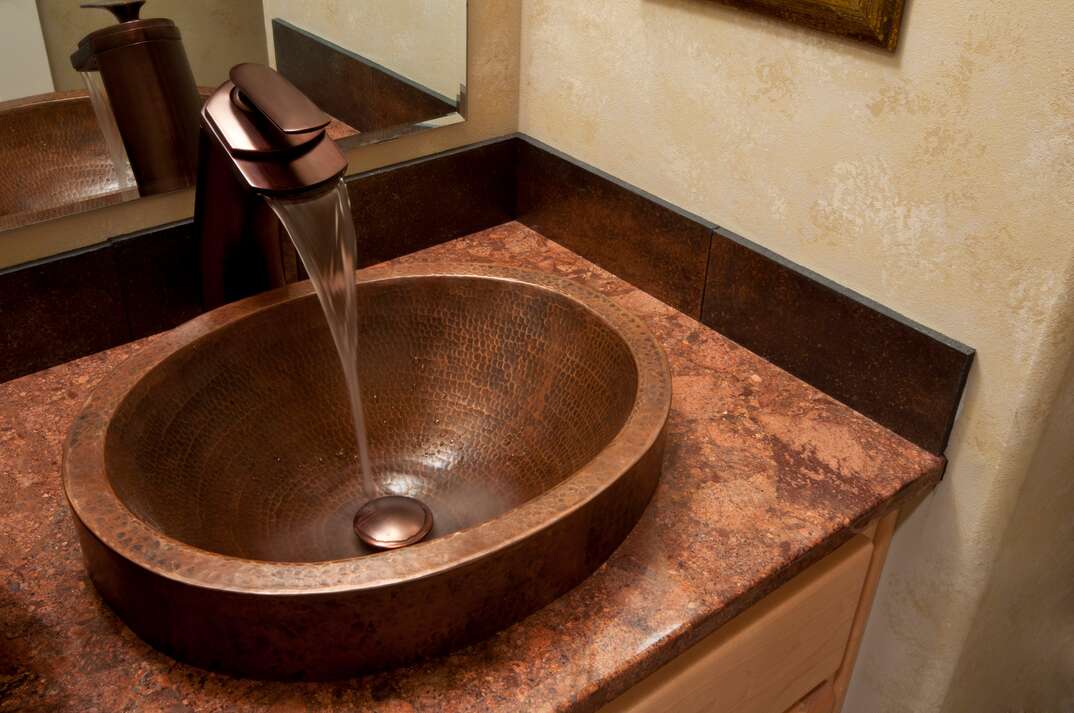How to Clean and Protect Your Copper Sink

A copper sink makes a stunning centerpiece for any kitchen or bathroom. But such a unique piece requires special attention. If you clean your copper sink like you would a run-of-the-mill stainless-steel model, you’ll probably end up disappointed.
This May Also Interest You: No Hogwash: How to Install a Farmhouse Sink in 9 Steps
There are a few rules you’ll need to follow to protect the copper — and you’ll want to make sure everyone in your household is aware of them. Knowing what cleaners to use and avoid is the key to caring for your sink. Here’s a guide.
Copper Sink Finishes
Many metal finishes in your home — like metal fixtures or knobs — maintain the same appearance over time. Copper is different in that the color and tone can change over time as it develops its patina, a protective coating. This often causes a copper sink to change to a darker color, losing its original shine. Regular cleaning won’t hinder the natural development of patina or tarnish. It protects the metal to ensure the sink stays protected.
Some things can strip the patina from the copper sink, like acidic foods, certain cosmetics, bleach and other harsh chemicals. You know those penny-cleaning experiments you did as a kid? Leave a tarnished copper-plated penny in vinegar or lemon juice overnight, and it’ll be shiny by the next morning. The same logic applies here. If the dark finish is removed, the damage isn't to the copper itself; it's simply removing the patina. It'll come back in time, though the sink’s surface may look blotchy or uneven until it does.
How Can I Make My Copper Sink Shine?
Just like you want your stainless appliances to stay sparkling clean, you might also prefer to keep your copper sink shiny instead of developing a darker patina. Buying a lacquered copper sink will slow down the development of patina, helping you maintain shine. However, you’ll still need to care for it regularly to keep it that way.
To get the like-new look, clean and wax the sink regularly. If the sink starts to get dark, use copper polish to restore it. Make sure the polish is designed for copper. After polishing, apply copper wax and buff it to get the shine you want. Do this every four to six weeks, or more often if you notice the sink starting to discolor.
How Do You Make a Copper Sink Look New?
Dish soap and water make a simple, effective copper cleaner for your sink. If you have stains in your copper sink, mix a paste of baking soda and water to remove them.
Knowing what not to use to clean your copper sink is also important. Skip any harsh or abrasive cleaning solutions or tools. That includes scrubbing-type cleansers with abrasive materials, harsh chemicals and bleach-based cleaners. You’ll also want to skip the steel wool and cleaning pads with abrasive surfaces.
More Related Articles:
- How Much Does It Cost to Install a Kitchen Sink?
- How Much Does It Cost to Replace a Bathroom Sink?
- Everything ‘Bout the Kitchen Sink: A 5-Step Installation Guide
- How to Replace or Install a Bathroom Faucet
- How Much Does It Cost to Install or Replace a Garbage Disposal
How to Clean a Copper Sink
Start with a thorough rinse using your sprayer to remove any food particles or debris. Add a few drops of dishwashing soap to your clean, wet sponge or soft cloth. Rub it on all surfaces of the sink to create suds and wash away food and debris. Rinse the sink thoroughly, and dry it with a lint-free towel.
For stains, mix baking soda with a few drops of water to form a paste. Use a sponge to scrub it onto the stain. This cleaning paste also works on green spots — called verdigris — that can develop on copper. Rinse the paste thoroughly after removing the stain, then dry the sink.
Copper Sink Care Tips
Cleaning a copper sink isn't just about scrubbing. The way you use your sink on a daily basis affects the appearance. Rinse your copper sink after every use to prevent food or residue from building up. This helps remove acidic foods that can damage the patina. Drying the sink after rinsing can also protect the metal and reduce buildup, especially if you have hard water.
Avoid leaving cast iron skillets in the sink as the iron, copper and moisture combination can cause rust. You can also add a grid or tray insert to elevate pans and other items so they don't sit directly on the bottom of the sink.
Since we’re all home now more than ever, being prepared for unexpected home repairs with a plan from HomeServe is important. Having a plan in place gives you peace of mind knowing that you can simply call our 24/7 repair hotline for covered breakdowns. See what plans are available in your neighborhood.


